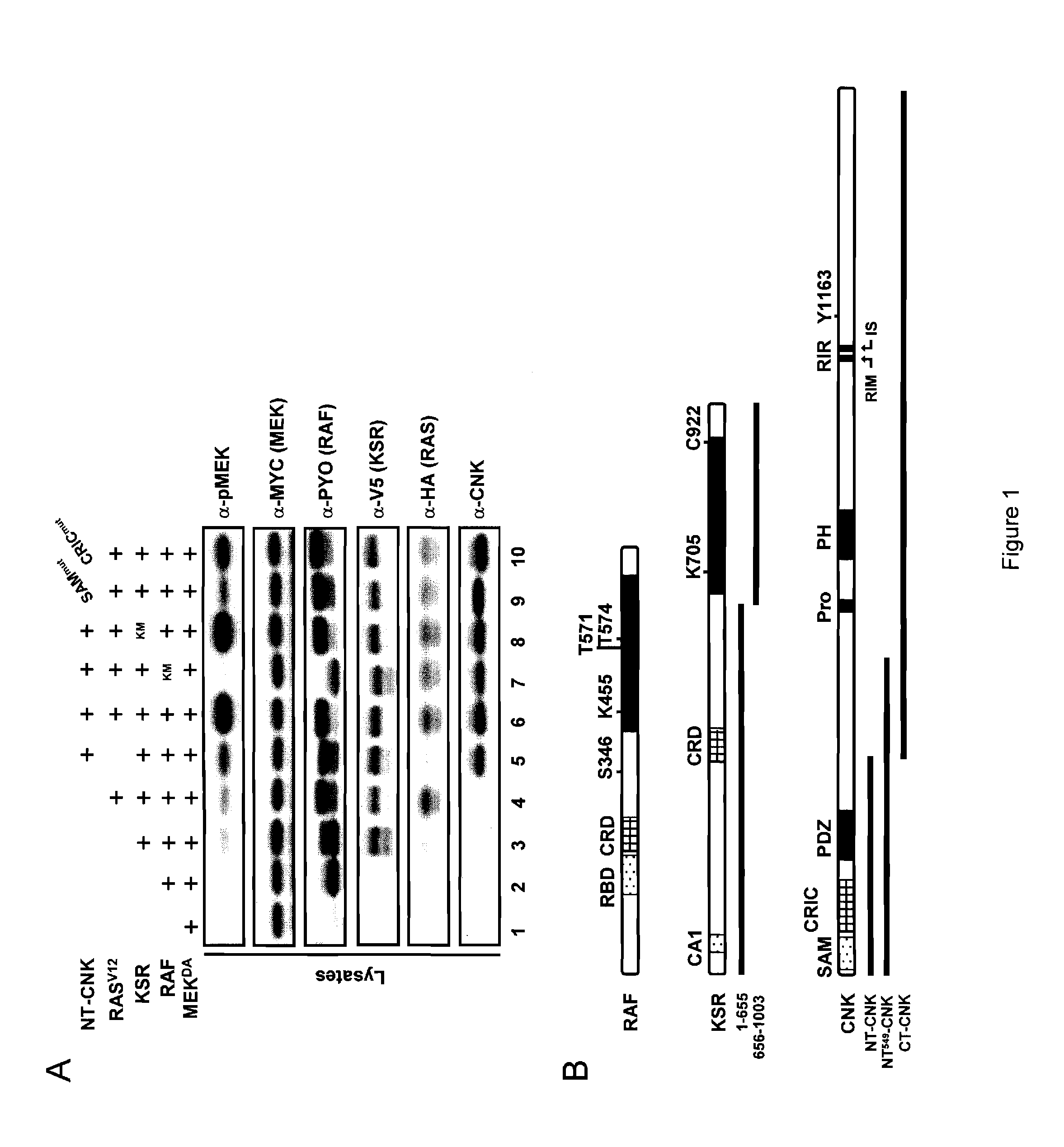Novel protein member of the ras/mapk pathway, antibodies thereof and methods and kits of using same
- Summary
- Abstract
- Description
- Claims
- Application Information
AI Technical Summary
Benefits of technology
Problems solved by technology
Method used
Image
Examples
example 1
CNK and KSR are Required for Activation of the Catalytic Domain of RAF
[0137]RAS-dependent activation of the MAPK module in Drosophila S2 cells was previously found to depend on two domains (SAM and CRIC) located in the amino-terminal portion of CNK (FIG. 1) and this requirement occurred at a step upstream of RAF (Douziech et al., 2003). This event was investigated at the molecular level, with a KSR-dependent MEK activation assay based on Drosophila proteins that was previously used to demonstrate KSR's ability to facilitate MEK phosphorylation by RAF (Roy et al., 2002). In that assay, co-expression of wild-type variants of epitope-tagged KSR, RAF and kinase-inactivated MEKDA, is sufficient to induce MEK phosphorylation on activating residues S237 and S241 (FIG. 1, compare lanes 1-3), which could be further enhanced by co-expression of RASV12 (lane 4). Interestingly, co-expression of NT-CNK (amino acid position 2-384; FIG. 1B) along with KSR, RAF and MEK, also enhanced MEK activation...
example 2
The Kinase Domain of KSR Mediates CNK Activity
[0141]Using a strategy analogous to the one used for RAF, it was next determined whether KSR is required for NT-CNK's positive function and if so, which structural feature of KSR was mediating the effect. Endogenous KSR was depleted by RNAi as in Example 1 (FIG. 2). First, a control experiment was conducted where RASV12, RAFWT and MEKDA were co-transfected in the absence of KSR to show its strict requirement for MEK phosphorylation (FIG. 4A, lane 1). Strikingly, co-transfection of NT-CNK under those conditions did not significantly elevate MEK phosphorylation nor did it increase RAF mobility shift (lane 2), thus demonstrating that KSR is essential for the positive effect of CNK on RAF. Indeed, introduction of KSR along with RASV12, RAFWT and MEKDA restored MEK activation (lane 3), which could be further enhanced by NT-CNK (lane 4). The impact of KSR mutants on the ability of NT-CNK to stimulate MEK phosphorylation was then tested. Two mu...
example 3
KSR is More than a Scaffold Connecting MEK to RAF
[0143]Mutations in KSR disrupting MEK or RAF binding, such as KSRCA1mut, KSRC922Y or KSRD800A-D817A had been previously shown to impair KSR activity and were actually used as evidence to argue that KSR has a scaffolding role within the MAPK module (Roy et al., 2002). Compared to KSRWT, KSRG688E also displayed lowered MEK binding activity (FIG. 6A, compare lanes 2 and 5), but interacted normally with RAF (FIG. 6B, compare lanes 2 and 5). The reduced association of KSRG688E to MEK is thus consistent with its loss-of-function behavior, although it is surprising that it is not more active than the two KSR mutants (KSRD800A-D817A and KSRC922Y) that entirely lost MEK binding (FIG. 6A, lanes 8 and 9). Unexpectedly, the two strongest mutants, KSRA696V-A703T and KSRR732H, showed normal association with either MEK (FIG. 6A, lanes 6 and 7) or RAF (FIG. 6B, lanes 6 and 7) and thus their inactivity could not be explained by a lack of MEK or RAF bi...
PUM
| Property | Measurement | Unit |
|---|---|---|
| Length | aaaaa | aaaaa |
| Biological properties | aaaaa | aaaaa |
Abstract
Description
Claims
Application Information
 Login to View More
Login to View More - R&D
- Intellectual Property
- Life Sciences
- Materials
- Tech Scout
- Unparalleled Data Quality
- Higher Quality Content
- 60% Fewer Hallucinations
Browse by: Latest US Patents, China's latest patents, Technical Efficacy Thesaurus, Application Domain, Technology Topic, Popular Technical Reports.
© 2025 PatSnap. All rights reserved.Legal|Privacy policy|Modern Slavery Act Transparency Statement|Sitemap|About US| Contact US: help@patsnap.com



